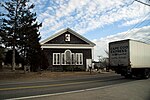Mercelia Evelyn Eldridge Kelley House
1877 establishments in MassachusettsChatham, MassachusettsHouses completed in 1877Houses on the National Register of Historic Places in Barnstable County, MassachusettsItalianate architecture in Massachusetts ... and 2 more
National Register of Historic Places in Barnstable County, MassachusettsQueen Anne architecture in Massachusetts

The Mercelia Evelyn Eldridge Kelley House is a historic house at 2610 Main Street in Chatham, Massachusetts. The 2+1⁄2-story wood-frame house was built in 1877 and has vernacular Italianate styling. It is significant for its association with the Eldridge family, who were major landowners in South Chatham and promoted its development. The house was listed on the National Register of Historic Places in 2005.
Excerpt from the Wikipedia article Mercelia Evelyn Eldridge Kelley House (License: CC BY-SA 3.0, Authors, Images).Mercelia Evelyn Eldridge Kelley House
Main Street,
Geographical coordinates (GPS) Address Nearby Places Show on map
Geographical coordinates (GPS)
| Latitude | Longitude |
|---|---|
| N 41.678888888889 ° | E -70.026388888889 ° |
Address
Main Street 2620
02659
Massachusetts, United States
Open on Google Maps







